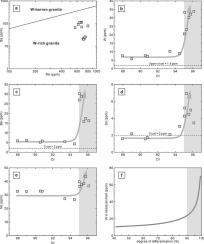Highly fractionated Eocene granites in the southern Lhasa subterrane: Implications for tungsten metallogeny and exploration
IF 3.6
2区 地球科学
Q1 GEOLOGY
引用次数: 0
Abstract
Highly differentiated granites are worldwide the primary source of W, Sn, and rare metals. Recently, a tourmaline granite was discovered in the Dagejia area in the western section of the southern Lhasa subterrane, southern Tibetan Plateau, where W mineralization is represented by quartz-tourmaline-wolframite veins in the granite. Two samples from the Dagejia tourmaline granite yielded weighted 206Pb/238U mean ages of 41.0 ± 0.5 Ma and 42.4 ± 0.5 Ma (Eocene). The Dagejia tourmaline granite is a typical S-type granite, characterized by high silica (SiO2 = 72.78–78.29 wt%) and high total alkali (Na2O + K2O = 5.01–9.93 wt%) contents, has a high aluminum saturation index (A/CNK = 1.06‒2.72), and high normative corundum contents (average: 4.0 wt%; range: 0.7‒10.1 wt%). The zircon grains have negative εHf(t) values (−3.96 to − 1.96) and Mesoproterozoic two-stage Hf model ages (TDM2 = 1243–1372 Ma). These characteristics, along with low whole-rock CaO/Na2O and low Nb/U ratios, and high Rb/Sr and high Rb/Ba ratios, point out that the Dagejia tourmaline granite derived from melting of a pelitic, mid- to upper crustal source. The Dagejia tourmaline granite displays high differentiation indexes (DI = 88–96), has low Zr/Hf and Nb/Ta ratios, and is depleted in Ba, Nb, Sr, Eu, and Ti, indicating that the granite is highly fractionated and has undergone a significant crystallization differentiation, involving amphibole, K-feldspar, plagioclase, and titanite. The W contents of the relatively primitive Dagejia tourmaline granite samples (DI = 88–94) are higher than those of the upper continental crust, showing that the magma source was pre-enriched in W. In addition, the W contents increased significantly when the DI exceeded 95, revealing an exceptionally high degree of differentiation triggering the further enrichment of the Dagejia tourmaline granite in W. Based on these geochemical characteristics and the presence of quartz-tourmaline-wolframite veins, the Dagejia tourmaline granite has the potential to have generated a fertile W mineralization. Combined with the W occurrences at Hahaigang, Nuri, Jiagang, and Jiaoxi, the Lhasa Terrane has a significant metallogenic potential for further W discoveries, particularly linked with highly fractionated granites.

拉萨南缘始新世高分异花岗岩:对钨成矿和找矿的指示意义
高度分化的花岗岩是世界范围内钨、锡和稀有金属的主要来源。大吉家电气石花岗岩样品的加权206Pb/238U平均年龄分别为41.0±0.5 Ma和42.4±0.5 Ma(始新世)。大家电气石花岗岩为典型的s型花岗岩,具有高硅(SiO2 = 72.78 ~ 78.29 wt%)和高总碱(Na2O + K2O = 5.01 ~ 9.93 wt%)含量、高铝饱和指数(a /CNK = 1.06 ~ 2.72)和高标准刚玉含量(平均4.0 wt%,范围0.7 ~ 10.1 wt%)的特点。锆石颗粒εHf(t)值为负(- 3.96 ~ - 1.96),中元古代两期Hf模式年龄(TDM2 = 1243 ~ 1372 Ma)。这些特征与低全岩CaO/Na2O和低Nb/U比值、高Rb/Sr和高Rb/Ba比值共同表明,大家岭电气石花岗岩形成于泥质熔融中上部地壳。大家岭碧石花岗岩分异指数高(DI = 88 ~ 96), Zr/Hf和Nb/Ta比值低,Ba、Nb、Sr、Eu和Ti富集,表明该花岗岩分异程度高,结晶分异程度明显,主要包括角闪洞、钾长石、斜长石和钛矿。相对原始的大家岭电气石花岗岩样品(DI = 88 ~ 94)的W含量高于上陆地壳样品,表明岩浆源对W进行了预富集,且当DI超过95时,W含量显著增加;根据这些地球化学特征和石英-电气石-黑钨矿脉的存在,认为大贾家电气石花岗岩具有形成丰富的W矿化的潜力。结合哈海岗、努里、嘉岗、角西等地的钨赋存,认为拉萨地体具有进一步发现钨的重要成矿潜力,特别是与高分选花岗岩有关。
本文章由计算机程序翻译,如有差异,请以英文原文为准。
求助全文
约1分钟内获得全文
求助全文
来源期刊

Ore Geology Reviews
地学-地质学
CiteScore
6.50
自引率
27.30%
发文量
546
审稿时长
22.9 weeks
期刊介绍:
Ore Geology Reviews aims to familiarize all earth scientists with recent advances in a number of interconnected disciplines related to the study of, and search for, ore deposits. The reviews range from brief to longer contributions, but the journal preferentially publishes manuscripts that fill the niche between the commonly shorter journal articles and the comprehensive book coverages, and thus has a special appeal to many authors and readers.
 求助内容:
求助内容: 应助结果提醒方式:
应助结果提醒方式:


